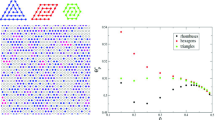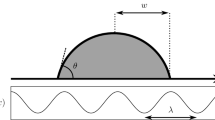Abstract
We investigate a novel model of pattern formation phenomena. In this model spherical droplets are nucleated on a substrate and grow at constant velocity; when two droplets touch each other they stop their growth. We examine the heterogeneous process in which the droplet formation is initiated on randomly distributed centers of nucleation and the homogeneous process in which droplets are nucleated spontaneously at constant rate. For the former process, we find that in arbitrary dimensiond the system reaches a jamming state where further growth becomes impossible. For the latter process, we observe the appearance of fractal structures. We develop mean-field theories that predict that the fraction of uncovered material Φ(t) approaches to the jamming limit as Φ(t)−Φ(∞)∼exp(Ct d) for the heterogeneous process and as a power law for the homogeneous process. Exact solutions in one dimension are obtained and numerical simulations ford=1–3 are performed and compared with mean-field predictions.
Similar content being viewed by others
References
J. W. Cristian,The Theory of Phase Transformations in Metals and Alloys, Part 1: Equilibrium and General Kinetic Theory (Pergamon Press, New York, 1981).
J. D. Gunton and M. Droz,Introduction to the Theory of Metastable and Unstable States (Springer-Verlag, New York, 1983).
R. J. Field and M. Burger, eds.,Oscillations and Travelling Waves in Chemical Systems (Wiley, New York, 1985).
D. Beysens and C. M. Cnobler,Phys. Rev. Lett. 57:1433 (1986).
J. A. Glazier and D. Weaire,J. Phys. Cond. Matter 4:1867 (1992).
A. T. Florence, T. K. Law, and T. L. Whatley,J. Colloid Interface Sci. 107:584 (1985).
B. J. Mason,The Physics of Clouds (Oxford University Press, Oxford, 1957).
R. Zallen,The Physics of Amorphous Solids (Wiley, New York, 1983).
K. J. Maloy, J. Feder, and T. Jossang,Phys. Rev. Lett. 55:2688 (1985).
B. Lewis and J. C. Anderson,Nucleation and Growth of Thin Films (Academic Press, New York, 1978).
M. Hasegawa and M. Tanemura,Ann. Inst. Stat. Math. B 28:509 (1976).
J. W. Evans,Rev. Mod. Phys. 65:1281 (1993).
K. Sekimoto,Int. J. Mod. Phys. B 5:1843 (1991).
H. J. Herrmann, G. Mantica, and D. Bessis,Phys. Rev. Lett. 65:3223 (1990); H. J. Herrmann,Pour la Sci. 165:17 (1991).
S. S. Manna,Physica A 187:373 (1992).
B. B. Mandelbrot,The Fractal Geometry of Nature (Freeman, San Francisco, 1982).
S. Chandrasekhar,Rev. Mod. Phys. 15:1 (1943).
I. M. Lifshitz,Adv. Phys. 13:483 (1964).
R. M. Bradley and P. N. Strenski,Phys. Rev. B 40:8967 (1989).
Yu. A. Andrienko, N. V. Brilliantov, and P. L. Krapivsky,Phys. Rev. A. 45:2263 (1992); P. L. Krapivsky,J. Chem. Phys. 97:8817 (1992).
T. Vicsek,Physica A 168:490 (1990).
D. W. Boyd,Mathematica 20:170 (1973).
S. S. Manna and H. J. Herrmann,J. Phys. A 24:L481 (1991).
Author information
Authors and Affiliations
Rights and permissions
About this article
Cite this article
Andrienko, Y.A., Brilliantov, N.V. & Krapivsky, P.L. Pattern formation by growing droplets: The touch-and-stop model of growth. J Stat Phys 75, 507–523 (1994). https://doi.org/10.1007/BF02186870
Received:
Accepted:
Issue Date:
DOI: https://doi.org/10.1007/BF02186870




